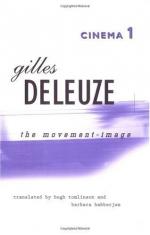|
This section contains 503 words (approx. 2 pages at 400 words per page) |

|
Figures, or the Transformation of Forms Summary and Analysis
The passage from one form to another in Eisenstein shows that the difference between the forms, i.e. Small and Large, is clear although their application is complex. Ford uses a large form predominantly but also creates masterpieces in "The Long Voyage Home" with the small form where sounds of airplanes signify attack. The terms Small and Large refer to a Platonic idea to precede scripting or occur in cutting and montage through "mise-en-scene" or setting. The Soviet film-maker Eisenstein masters both in a third law to overcome dialectic in "pathetisation," in which a small form grafts itself on a large form in combination. For example, in "Battleship Potemkin" Eisenstein uses landscape and the ship's foggy silhouette as "synsigns" while the captain's eyeglass is an "index" for transformation.
The figures of...
(read more from the Figures, or the Transformation of Forms Summary)
|
This section contains 503 words (approx. 2 pages at 400 words per page) |

|




